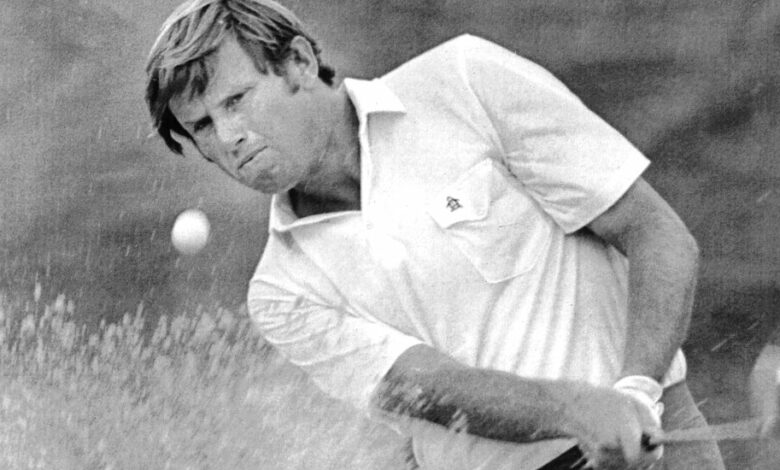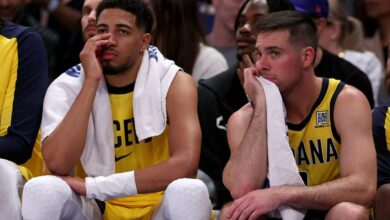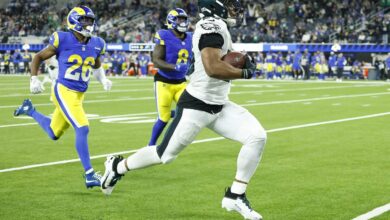Peter Oosterhuis, British golfer turned broadcaster, dies at the age of 75

Peter Oosterhuis, a British golfer who won 20 tournaments around the world, played in the Ryder Cup six times and later distinguished himself as a commentator for CBS Sports and Golf Channel, died Thursday in Charlotte, N.C. He was 75.
His wife, Ruth Ann (DuClos) Oosterhuis, said his death, in a memory care facility, was caused by complications from Alzheimer’s disease. He retired from CBS in early 2015, nearly two decades after he began working there and a few months after he was diagnosed with early-onset Alzheimer’s.
That year, Oosterhuis (pronounced OH-ster-house) spoke to Golf Digest about his life and career.
“The specific memories of those events are fading, but I have a good general sense of things,” he said. He did have one detailed memory: “In the 1973 Ryder Cup, I was playing Lee Trevino in one of my singles matches. Lee said to his teammates, ‘If I don’t beat Oosterhuis, I’m going to come here and kiss your asses.’ Lee didn’t beat me.”
Oosterhuis finished second in the 1974 British Open, four strokes behind Gary Player. Eight years later he finished second again, level with Nick Price, one stroke behind the winner, Tom Watson. The Guardian said Oosterhuis’ final round 70 in the 1982 Open was “a deserved reward for the bravest heart and most patient temperament that British golf has produced in the modern era.”
Oosterhuis was for a while one of the best golfers in Europe. He won the Harry Vardon Trophy, for the best scoring average on the European Tour, four times in a row, from 1971 to 1974. He won seven titles on the European Tour, now called the DP World Tour. And although his six Ryder Cup teams (first Great Britain and then Europe) lost to the United States from 1971 to 1981, he had his share of success, including a 6-2-1 record in his singles matches in that biennial League.
At his first Ryder Cup, in St. Louis in 1971, he was about to hit a long putt when a butterfly flew out of the hole.
He jumped up in surprise and made the putt for birdie.
Arnold Palmer – who lost to Oosterhuis in a singles match after winning two foursome matches and one fourball match – told The Decatur Daily Review of Illinois: “He’s good. What I like is that he thinks a lot while he plays.”
At the 1981 Canadian Open in Oakville, Ontario, he held off a late challenge from Nicklaus. This one needed a 20-foot eagle putt on the 18th hole to match it, but he came up about eight inches short.
It was Oosterhuis’s only title on the PGA Tour, where he played from 1975 to 1986.
“You’ve been very patient, Peter, and now you’ve won one,” Nicklaus told him.
“I don’t know if I’ve been patient or just stubborn,” Oosterhuis replied.
Peter Arthur Oosterhuis was born on 3 May 1948 in Dulwich, a district of South London. His father, Hans, was a commodities broker who fled the Netherlands after the German occupation. His mother, Josie (Frenken) Oosterhuis, ran the household.
His introduction to golf came when he was about 10 and his family went blackberry picking at Dulwich & Sydenham Hill Golf Club.
“The problem was that I ate all the blackberries I picked, so I was soon fired from that job and started playing golf instead,” he told Global Golf Post, a digital golf news publication. He joined the club as a junior and soon showed the talent that would see him represent Great Britain in the 1967 Walker Cup and the Eisenhower Trophy a year later. He turned pro at the age of twenty.
He left the PGA Tour in 1987 to become director of golf at Forsgate Country Club in Monroe Township, N.J. In 1991, he moved to Riviera Country Club in Los Angeles, where he served as head golf professional until 1993.
In the mid-1990s he turned to television commentary, first for Britain’s Sky Sports and then for the Golf Channel. He worked part-time as an analyst for CBS in 1997 and was hired full-time the following year. He was soon installed as a commentator, offering analysis from the 17th hole tower during the network’s golf broadcasts.
“He explained the game in front of him in a very relaxed way,” said Lance Barrow, the former coordinating golf producer at CBS Sports, who brought Oosterhuis to the network. “He gave you the information you needed, got out of the way and let the pictures tell the story.”
During the final round of the 2000 Masters, Oosterhuis gave a particularly blunt assessment of a putt by Vijay Singh.
“That’s a terrible misjudgment of the line,” he said. “He knew it was going to be slippery, but he just started in the wrong direction. About the worst putt we’ve ever seen.”
In addition to his wife, known as Roothie, Oosterhuis is also survived by his sons Robert and Richard from his marriage to Anne Coney, which ended in divorce; his stepsons, Byron and Mathew Bos; and four grandchildren.
When Oosterhuis reminisced for Golf Digest after his diagnosis, he talked about his sister Gillian, who left $25,000 to an Alzheimer’s charity after her death in 2014.
“This was before I was diagnosed,” he said, “and she had no idea there was anything unusual going on with me. She did that because she believed my father, who died about 10 years ago, had the disease, even though he was never diagnosed.”




